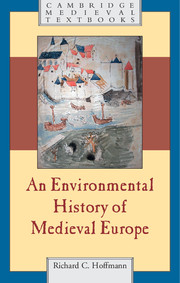Book contents
- Frontmatter
- Contents
- List of figures
- List of maps
- Preface
- Frontispiece: Nature and culture at Waterford, Ireland, 1372
- Introduction: Thinking about medieval Europeans in their natural world
- 1 Long no wilderness
- 2 Intersecting instabilities: culture and nature at medieval beginnings, c.400–900
- 3 Humankind and God’s Creation in medieval minds
- 4 Medieval land use and the formation of traditional European landscapes
- 5 Medieval use, management, and sustainability of local ecosystems, 1: primary biological production sectors
- 6 Medieval Use, management, and sustainability of local ecosystems, 2: interactions with the non-living environment
- 7 ‘This belongs to me . . .’
- 8 Suffering the uncomprehended: disease as a natural agent
- 9 An inconstant planet, seen and unseen, under foot and overhead
- 10 A slow end of medieval environmental relations
- Afterword
- A sampler for further reading
- Index
- References
5 - Medieval use, management, and sustainability of local ecosystems, 1: primary biological production sectors
Published online by Cambridge University Press: 05 July 2014
- Frontmatter
- Contents
- List of figures
- List of maps
- Preface
- Frontispiece: Nature and culture at Waterford, Ireland, 1372
- Introduction: Thinking about medieval Europeans in their natural world
- 1 Long no wilderness
- 2 Intersecting instabilities: culture and nature at medieval beginnings, c.400–900
- 3 Humankind and God’s Creation in medieval minds
- 4 Medieval land use and the formation of traditional European landscapes
- 5 Medieval use, management, and sustainability of local ecosystems, 1: primary biological production sectors
- 6 Medieval Use, management, and sustainability of local ecosystems, 2: interactions with the non-living environment
- 7 ‘This belongs to me . . .’
- 8 Suffering the uncomprehended: disease as a natural agent
- 9 An inconstant planet, seen and unseen, under foot and overhead
- 10 A slow end of medieval environmental relations
- Afterword
- A sampler for further reading
- Index
- References
Summary
This chapter and the next examine how medieval Europeans made use of their local ecosystems and historic consequences of those uses. The first of the pair has to do with biomass, hence with living things, and attempts an ecological understanding of primary biological production sectors in the Middle Ages. To start, agriculture and related activities are considered as anthropogenic ecosystems; sections thereafter treat medieval colonization and exploitation of natural wild ecosystems through wood cutting, hunting, and fishing. In each instance the aim is to gain a sense of operational features – how things worked – and to assess their sustainability. The following chapter will turn to non-living aspects of the environment. While chapter 4 was about change and its impact, chapters 5 and 6 treat structures, how they worked, and the extent to which they were sustainable.
Sustainability in systems based on indirect solar energy
All pre-industrial societies live off solar energy from biomass production, the living materials that green plants create by photosynthesis. Agrarian societies since the Neolithic had domesticated biomass production, but their regular use of the wild world also fits the same parameters. Medieval Europeans in particular organized themselves and their colonization of nature for this purpose. Grasp of the long-run operation of medieval agroecosystems must start from thinking in metabolic terms about the whole society and its component units of production and consumption – farming households. Parts and whole alike needed sufficient and stable energy and other inputs to ensure regular outputs at sufficient rates of return without in the process generating more waste than the surrounding natural system could safely absorb.
- Type
- Chapter
- Information
- An Environmental History of Medieval Europe , pp. 155 - 195Publisher: Cambridge University PressPrint publication year: 2014



